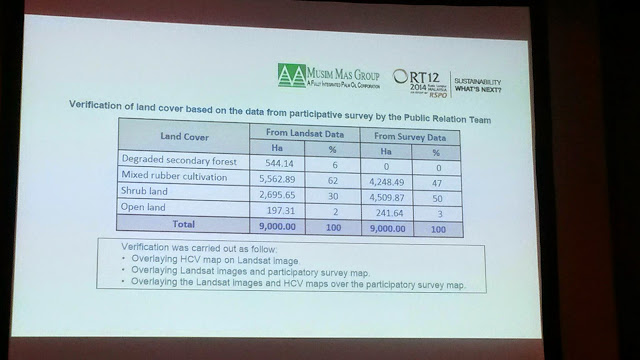RSPO’s Melissa Chin reported on how RSPO growers need to predict emissions from different development scenarios for their new plantings. In 2013, the Emission Reduction Working Group (ERWG) was set up to help companies on this new reporting requirement. The policy to assess and predict GHG emissions reductions is in RSPO Principles & Criteria 7.8. Previously required from 1 Aug 2014 it was shifted to mandatory on 1 Jan 2015. This needs to be submitted alongside New Planting Procedure but it is not required to be made public until 1 Jan 2017. Soil carbon, above and below ground carbon estimates are needed.....
Bumitama case study. GAR and Wilmar are key buyers requiring high carbon stock (HCS) policies. A mid-year discussion led to a pilot HCS assessment using their approach. Bumitama then committed on 12 September 2014 to use this on four target concessions. Concession KML had a base case plantable area of about 12,500 but was reduced to about 6,600 hectares on the planting scenario chosen. There was no planting on any peat (base case was plant on shallow peat). Significant areas of rubber agro-forest areas could not be replanted due to social or adat issues. Local people expect economic projects. They lodged a complaint with the regional government or Bupati on why Bumitama stopped development. Aidenvironment was hired to work on participatory mapping. Locals wanted to stop access to this NGO until it was shown that it worked with company to develop the land. The halt in development it also gave third parties the opportunity to approach the masyarakat to suggest a takeover so that the concession could return to faster development and some 1,000 hectares was “lost.” Planting less than the 12,500 hectares originally envisaged also means that the 20 percent area for plasma smallholder development is so much smaller under the new planting scenario. Bumitama has also engaged a lawyer to check if it has the right to conserve area to reforest. Can this really be done. However, a company still has to be run economically.....

Musim Mas case study. Using the RSPO carbon assessment procedure, Musim Mas presented two case studies, one already in new planting status and one before planting. The result was a GHG balance of -5 and -14 respectively; which means there was carbon sequestration from the two new estates. The company notes that the current default value for conservation areas is nil, but this is being reviewed and this will likely add on to the positive carbon balance of planting oil palm. Musim Mas is also doing mill POME biogas capture for all its facilties. These efforts will minimise its net GHG emissions........
Note: inherent in the RSPO carbon assessment are default values that will steer new plantings to minimize planting in high carbon stock areas. Under RSPO's Palm GHG calculator for carbon assessment, the default value for the oil palm is not bad ie. well above the earlier much bandied 35tC/ha measure. It is 55-65tC/ha of above and below ground carbon over a 25 year cycle.




